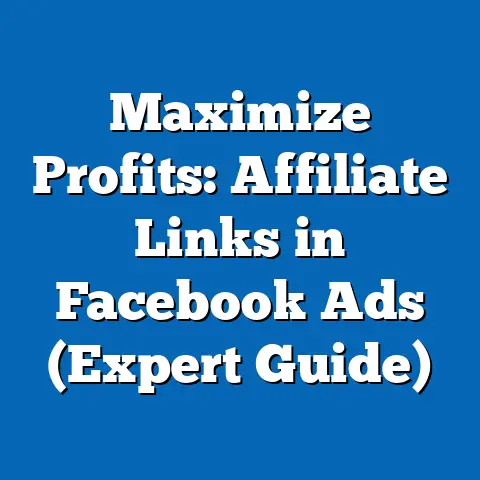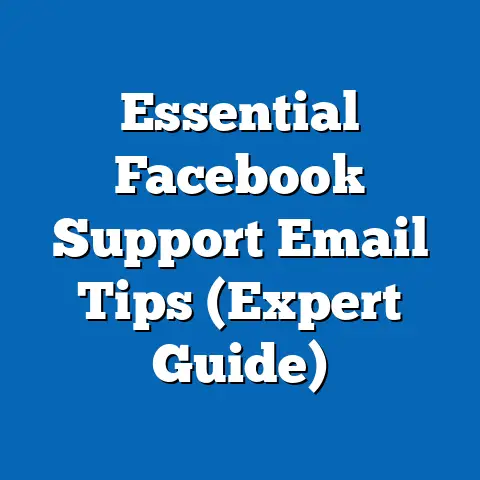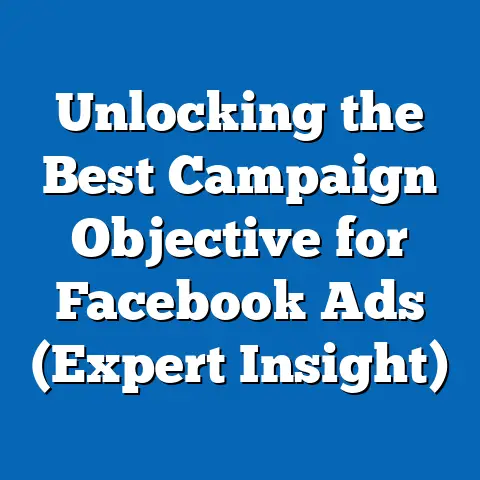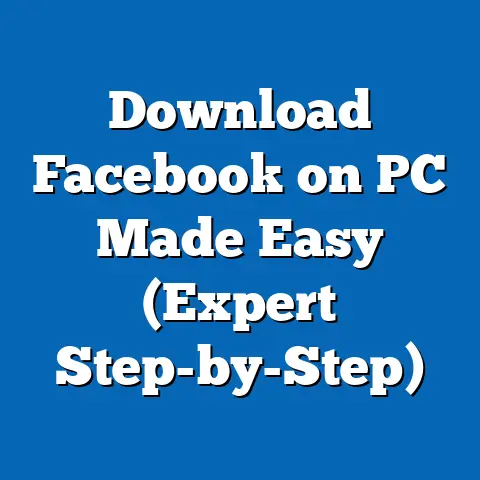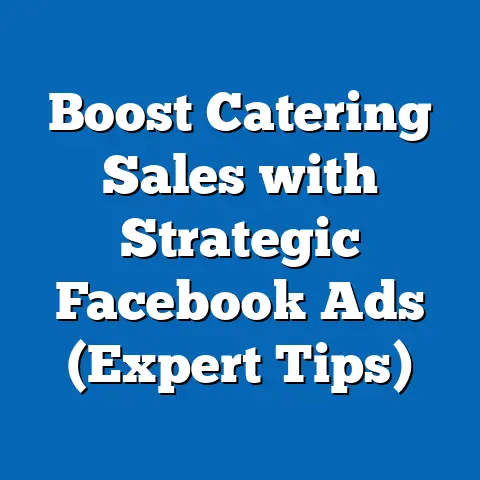Maximize Reach with Facebook Opt-Out Ads (Novel Strategies)
Maximize Reach with Facebook Opt-Out Ads: Novel Strategies for 2024
Facebook, even in 2024, remains a titan in the digital advertising arena. It’s where billions connect, share, and discover, making it an indispensable platform for businesses aiming to scale their reach. However, the digital marketing landscape is constantly shifting, especially when it comes to consumer privacy. We’re seeing a clear trend: users are becoming more aware and protective of their data. They’re actively choosing to opt-out of personalized advertising, and rightfully so.
This shift presents a unique conundrum for marketers. How do we effectively reach our target audience when they’ve essentially put up a digital shield? The answer lies in adapting, innovating, and embracing a new era of advertising that respects user privacy while still delivering compelling and relevant messages.
That’s where Facebook Opt-Out Ads come into play. These aren’t ads that force themselves onto users who’ve opted out of tracking. Instead, they represent a strategic approach that focuses on reaching audiences through means that don’t rely solely on personalized data. Think contextual relevance, community engagement, and emotionally resonant storytelling.
In this article, I’ll guide you through a series of novel strategies designed to maximize your reach on Facebook, even with the growing trend of opt-out preferences. We’ll explore how to leverage user-generated content, harness the power of contextual advertising, build thriving brand communities, master the art of storytelling, and redefine our metrics for success. Get ready to unlock a new level of effectiveness in your Facebook advertising efforts. This isn’t just about surviving in a privacy-conscious world; it’s about thriving in it.
Understanding Facebook Opt-Out Ads
So, what exactly are Facebook Opt-Out Ads? The term itself might be a bit misleading. It doesn’t refer to a specific ad format within Facebook’s Ads Manager. Instead, it’s an overarching strategy that encompasses various tactics to reach users who have limited or opted out of personalized ad targeting.
Think of it this way: traditional Facebook ads rely heavily on data collected about users – their interests, demographics, behaviors, and more. When a user opts out of ad tracking, they essentially limit the amount of data Facebook can use to personalize the ads they see. This means the typical targeting options become less effective, or even completely unavailable for that user.
Opt-Out Ads, therefore, are designed to work around these limitations. They focus on reaching users through alternative methods that don’t depend on personal data. This can include:
- Contextual Targeting: Showing ads based on the content a user is currently viewing.
- Interest-Based Targeting (but broader): Targeting users based on general interests they’ve expressed, rather than highly specific behaviors.
- Demographic Targeting (with caution): Using demographic data like age and location, but avoiding overly specific or potentially discriminatory targeting.
- Brand Awareness Campaigns: Focusing on building overall brand recognition rather than driving immediate conversions.
The implications of user opt-out choices are significant. It impacts everything from targeting accuracy and reach potential to the overall cost and effectiveness of your campaigns. Without personalized data, it becomes more challenging to pinpoint your ideal customer. Your reach might be broader, but less precise.
To illustrate the growing prevalence of opt-out behaviors, consider these statistics:
- Apple’s App Tracking Transparency (ATT): Since Apple introduced ATT in 2021, which requires apps to ask for permission to track users across other apps and websites, the vast majority of users have opted out. Estimates suggest that only around 25% of users globally allow tracking.
- Facebook’s Own Data: Facebook has acknowledged the impact of ATT on its advertising revenue, stating that it expects to see a significant decrease in its ability to target and measure ads.
- General Privacy Concerns: Surveys consistently show that a large percentage of internet users are concerned about their online privacy and are taking steps to protect their data, including using ad blockers, VPNs, and adjusting their privacy settings.
These numbers paint a clear picture: user privacy is a major concern, and opt-out behaviors are on the rise. This isn’t just a trend; it’s a fundamental shift in the digital landscape.
Furthermore, the legal and ethical implications of opt-out advertising cannot be ignored. Regulations like GDPR (General Data Protection Regulation) in Europe and CCPA (California Consumer Privacy Act) in the US are setting stricter standards for data privacy and requiring businesses to be more transparent about how they collect and use user data.
Ignoring these regulations can lead to hefty fines and damage your brand’s reputation. More importantly, it’s simply the right thing to do. Respecting user privacy is not just a legal obligation; it’s an ethical imperative.
Key Takeaways:
- Facebook Opt-Out Ads are a strategic approach to reaching users who have limited or opted out of personalized ad targeting.
- User opt-out choices have significant implications for targeting accuracy, reach, and campaign effectiveness.
- User privacy is a growing concern, and opt-out behaviors are on the rise.
- Legal and ethical considerations are paramount in opt-out advertising.
Next Steps:
- Familiarize yourself with data privacy regulations like GDPR and CCPA.
- Audit your current Facebook advertising campaigns to identify areas where you rely heavily on personalized data.
- Start brainstorming alternative targeting strategies that don’t depend on personal data.
Analyzing Current Trends in Consumer Behavior
To effectively navigate the world of Facebook Opt-Out Ads, it’s crucial to understand the driving forces behind consumer behavior when it comes to privacy and data sharing. What are the key trends shaping user preferences, and how can we adapt our advertising strategies accordingly?
Let’s start with the overarching trend: increased awareness and skepticism. Consumers are no longer blindly trusting companies with their data. They’ve witnessed data breaches, privacy scandals, and the pervasive nature of online tracking. This has led to a heightened sense of awareness and a growing desire to control their personal information.
This skepticism manifests in several ways:
- Increased Use of Ad Blockers: Ad blockers are becoming increasingly popular, preventing ads from being displayed on websites and within apps.
- Adjusting Privacy Settings: Users are actively adjusting their privacy settings on social media platforms and other online services to limit the amount of data they share.
- Using Privacy-Focused Browsers and Search Engines: Some users are switching to browsers and search engines that prioritize privacy, such as DuckDuckGo and Brave.
- Demanding Transparency and Control: Consumers are demanding greater transparency from companies about how their data is collected, used, and shared. They also want more control over their personal information, including the ability to access, correct, and delete their data.
Demographic shifts also play a significant role in shaping user preferences towards advertising. For example:
- Younger Generations (Gen Z and Millennials): These generations are generally more tech-savvy and privacy-conscious than older generations. They’ve grown up in a digital world and are acutely aware of the potential risks of sharing their data online. They are also more likely to support brands that align with their values and respect their privacy.
- Older Generations (Baby Boomers and Gen X): While older generations may be less tech-savvy, they are still concerned about their privacy, particularly when it comes to financial information and identity theft. They may be more likely to trust traditional advertising methods and less likely to engage with personalized ads.
- Location and Cultural Background: User preferences towards advertising can also vary depending on their location and cultural background. For example, users in Europe, where GDPR is in effect, may be more privacy-conscious than users in other regions.
To illustrate how brands have successfully engaged consumers who opt-out of traditional ad targeting, let’s examine a few case studies:
- Dove’s “Real Beauty” Campaign: Dove’s “Real Beauty” campaign is a classic example of emotionally resonant storytelling. The campaign focused on celebrating diverse body types and challenging traditional beauty standards. It resonated deeply with consumers and generated significant organic reach and engagement, even among those who had opted out of traditional ad targeting. The campaign’s success was due to its authenticity and its ability to connect with consumers on a personal level.
- REI’s #OptOutside Campaign: REI’s #OptOutside campaign is a prime example of a brand aligning with its customers’ values. The campaign encouraged people to spend time outdoors on Black Friday instead of shopping. It resonated with REI’s customers, who are passionate about outdoor activities, and generated significant positive publicity and brand loyalty. The campaign’s success was due to its alignment with REI’s brand values and its ability to connect with consumers on an emotional level.
- GoPro’s User-Generated Content Strategy: GoPro has built a massive following by encouraging its customers to share their own photos and videos taken with GoPro cameras. This user-generated content is authentic, engaging, and showcases the versatility of GoPro products. It has helped GoPro reach a wider audience and build a strong brand community, even among those who have opted out of traditional ad targeting.
To visualize these changes in consumer sentiment, consider the following (hypothetical) data:
- Graph 1: Percentage of Internet Users Using Ad Blockers (2018-2024) – A line graph showing a steady increase in ad blocker usage over time.
- Graph 2: Consumer Trust in Social Media Advertising (2018-2024) – A line graph showing a decline in consumer trust in social media advertising over time.
- Chart 1: Top Concerns About Online Privacy (2024) – A pie chart showing the percentage of users who are concerned about various aspects of online privacy, such as data breaches, identity theft, and tracking.
Key Takeaways:
- Consumers are increasingly aware and skeptical of online advertising and data collection.
- Demographic shifts play a significant role in shaping user preferences towards advertising.
- Brands can successfully engage consumers who opt-out of traditional ad targeting by focusing on authenticity, values alignment, and emotional connection.
Next Steps:
- Conduct market research to understand your target audience’s privacy concerns and preferences.
- Analyze your brand’s values and identify opportunities to align with your customers’ values.
- Start experimenting with different advertising strategies that prioritize authenticity and emotional connection.
Novel Strategies to Maximize Reach with Opt-Out Ads
Now, let’s get to the heart of the matter: the strategies you can implement today to maximize your reach on Facebook, even with the growing trend of opt-out preferences. These aren’t just theoretical ideas; they’re proven approaches that have worked for other brands, and that you can adapt to your own business.
Strategy 1: Leveraging User-Generated Content
User-generated content (UGC) is a goldmine for reaching opt-out audiences. Why? Because it’s authentic, engaging, and comes directly from your customers. It’s not a brand telling people how great they are; it’s other people telling them.
When customers create content that resonates with your audience, it fosters a sense of community and builds trust. It also provides valuable social proof, which can be incredibly persuasive.
Here’s how you can effectively leverage UGC:
- Run Contests and Giveaways: Encourage customers to submit photos, videos, or stories related to your brand or products. Offer prizes for the best submissions. This is a great way to generate a large volume of UGC quickly.
- Create a Branded Hashtag: Encourage customers to use a branded hashtag when sharing content related to your brand. This makes it easy to find and curate UGC.
- Feature UGC on Your Facebook Page: Regularly share UGC on your Facebook page. This shows your customers that you value their contributions and encourages others to participate.
- Incorporate UGC into Your Ads: Use UGC in your Facebook ads. This can make your ads feel more authentic and engaging.
- Partner with Influencers: Collaborate with influencers to create UGC that promotes your brand. Influencers can reach a wider audience and generate high-quality UGC.
For example, let’s say you sell outdoor gear. You could run a contest asking customers to submit photos of themselves using your gear on their adventures. You could then feature the best photos on your Facebook page and in your ads. This would not only generate valuable UGC but also showcase the versatility and durability of your products.
Another example is the ice cream brand Ben & Jerry’s. They often repost photos and videos of customers enjoying their ice cream, creating a sense of community and showcasing the deliciousness of their products.
Key Takeaways:
- UGC is authentic, engaging, and builds trust.
- Run contests and giveaways to generate UGC.
- Create a branded hashtag to make it easy to find and curate UGC.
- Feature UGC on your Facebook page and in your ads.
- Partner with influencers to create UGC.
Next Steps:
- Brainstorm ideas for contests and giveaways that would resonate with your target audience.
- Create a branded hashtag for your brand.
- Start curating UGC from your existing customers.
- Identify influencers who align with your brand and target audience.
Strategy 2: Implementing Contextual Advertising
Contextual advertising is all about showing ads that are relevant to the content a user is currently viewing. It’s a powerful alternative to personalized targeting because it doesn’t rely on personal data. Instead, it focuses on the context of the user’s browsing activity.
Think of it like this: if someone is reading an article about gardening, they might be interested in seeing ads for gardening tools or seeds. The ad is relevant to their current interest, regardless of their past browsing history or demographic information.
Here’s how you can effectively implement contextual advertising on Facebook:
- Target Interests: Facebook allows you to target users based on their interests. While this isn’t as precise as personalized targeting, it can still be effective if you choose your interests carefully. For example, if you sell fitness apparel, you could target users who are interested in fitness, yoga, or running.
- Use Keyword Targeting: Some ad platforms allow you to target ads based on keywords that appear in the content a user is viewing. This can be a more precise form of contextual advertising.
- Create Relevant Ad Copy and Visuals: Make sure your ad copy and visuals are relevant to the content a user is viewing. This will increase the likelihood that they will click on your ad.
- Test Different Contextual Targeting Options: Experiment with different interests and keywords to see what works best for your target audience.
- Use Placement Targeting: Focus on placements within Facebook that are more likely to display ads in a contextual manner, such as Facebook Articles or Instant Articles.
For example, let’s say you sell travel insurance. You could target users who are reading articles about travel destinations or travel tips. You could then create ad copy that highlights the benefits of travel insurance and includes a call to action to get a quote.
Another example is the online language learning platform Duolingo. They often show ads for their app when users are reading articles about learning a new language, making the ad highly relevant to the user’s current interest.
Key Takeaways:
- Contextual advertising shows ads that are relevant to the content a user is currently viewing.
- It doesn’t rely on personal data.
- Target interests and keywords carefully.
- Create relevant ad copy and visuals.
- Test different contextual targeting options.
Next Steps:
- Research the interests and keywords that are relevant to your target audience.
- Create ad copy and visuals that are tailored to those interests and keywords.
- Set up a Facebook ad campaign using contextual targeting options.
- Monitor your results and make adjustments as needed.
Strategy 3: Building Brand Communities
Building a brand community on Facebook is a powerful way to engage users who have opted out of traditional ad targeting. A brand community is a group of people who share a common interest in your brand and its products or services.
When users voluntarily join a brand community, they are essentially giving you permission to communicate with them. This allows you to build relationships with them, provide them with valuable content, and promote your products or services in a non-intrusive way.
Here’s how you can effectively build a brand community on Facebook:
- Create a Facebook Group: Create a Facebook group specifically for your brand community. This will give your community a dedicated space to connect with each other and with your brand.
- Provide Valuable Content: Share valuable content with your community, such as tips, tutorials, behind-the-scenes glimpses, and exclusive offers. This will keep your community engaged and coming back for more.
- Encourage Interaction: Encourage members of your community to interact with each other. Ask questions, start discussions, and run polls. This will foster a sense of community and make your members feel more connected to your brand.
- Respond to Comments and Questions: Regularly respond to comments and questions from members of your community. This shows them that you care about their feedback and are committed to providing them with excellent customer service.
- Run Exclusive Events and Promotions: Run exclusive events and promotions for members of your community. This will reward them for their loyalty and encourage them to stay engaged.
For example, let’s say you sell coffee. You could create a Facebook group for coffee lovers. You could then share tips on brewing the perfect cup of coffee, provide behind-the-scenes glimpses of your coffee roasting process, and offer exclusive discounts to members of the group.
Another example is the cosmetics brand Sephora. They have a very active Facebook group where members share makeup tips, ask questions, and review products. Sephora staff regularly participate in the group, providing expert advice and answering questions.
Key Takeaways:
- A brand community is a group of people who share a common interest in your brand.
- Create a Facebook group for your brand community.
- Provide valuable content to keep your community engaged.
- Encourage interaction among members of your community.
- Respond to comments and questions from members of your community.
- Run exclusive events and promotions for members of your community.
Next Steps:
- Create a Facebook group for your brand community.
- Develop a content strategy for your Facebook group.
- Start promoting your Facebook group to your existing customers.
- Actively engage with members of your Facebook group.
Strategy 4: Utilizing Storytelling and Emotional Appeal
In a world saturated with ads, it’s easy for your message to get lost in the noise. But storytelling and emotional appeal can cut through the clutter and connect with your audience on a deeper level.
When you tell a compelling story, you capture your audience’s attention and make them care about your brand. When you appeal to their emotions, you create a lasting impression and build a stronger connection.
Here’s how you can effectively utilize storytelling and emotional appeal in your Facebook ad campaigns:
- Focus on the “Why”: Don’t just tell people what your product or service is; tell them why it matters. What problem does it solve? What benefit does it provide? What impact does it have on people’s lives?
- Create Characters: Create relatable characters that your audience can identify with. These characters can be real people or fictional personas.
- Tell a Journey: Take your audience on a journey. Show them the challenges, the triumphs, and the transformations that your product or service can help them achieve.
- Use Visuals: Use compelling visuals to enhance your storytelling. Images and videos can evoke emotions and bring your story to life.
- Be Authentic: Be authentic in your storytelling. Don’t try to be someone you’re not. Be true to your brand and your values.
For example, let’s say you sell life insurance. You could tell a story about a family who was able to stay afloat after the unexpected death of a loved one thanks to a life insurance policy. You could use visuals of the family spending time together and enjoying life to evoke emotions of love, security, and peace of mind.
Another example is the clothing brand Patagonia. They often tell stories about their commitment to environmental sustainability and social responsibility. These stories resonate with their customers, who are passionate about these issues, and help to build a strong brand identity.
Key Takeaways:
- Storytelling and emotional appeal can cut through the clutter and connect with your audience on a deeper level.
- Focus on the “why” behind your product or service.
- Create relatable characters.
- Tell a journey.
- Use compelling visuals.
- Be authentic in your storytelling.
Next Steps:
- Brainstorm stories that you can tell about your brand, your products, or your customers.
- Develop characters that your target audience can identify with.
- Create visuals that will enhance your storytelling.
- Start incorporating storytelling and emotional appeal into your Facebook ad campaigns.
Strategy 5: Exploring Alternative Metrics and KPIs
In the world of opt-out ads, traditional metrics like clicks and conversions may not tell the whole story. You need to redefine success and focus on alternative metrics and KPIs (Key Performance Indicators) that provide a more holistic view of your campaign’s impact.
Here are some alternative metrics and KPIs to consider:
- Brand Sentiment: Measure how people feel about your brand. Are they saying positive things? Are they recommending you to others? You can use social listening tools to track brand sentiment.
- Community Engagement: Measure the level of engagement within your brand community. Are people actively participating in discussions? Are they sharing your content?
- Organic Reach: Measure the number of people who are seeing your content organically, without you paying for it. This is a good indicator of how engaging and shareable your content is.
- Website Traffic (From Non-Paid Sources): Monitor the traffic to your website from sources other than paid advertising. This can include organic search, social media, and referral traffic.
- Customer Lifetime Value (CLTV): Measure the total revenue you expect to generate from a customer over the course of their relationship with your brand. This is a good indicator of the long-term value of your customers.
- Return on Ad Spend (ROAS) – with Attribution Modeling: Even with opt-outs, track ROAS, but use attribution modeling to understand the full impact of your campaigns, including the influence on later conversions.
For example, let’s say you’re running a brand awareness campaign. You might not see a lot of clicks or conversions, but you might see a significant increase in brand sentiment and organic reach. This would indicate that your campaign is successful in raising awareness of your brand and building a positive reputation.
Another example is if you’re running a community engagement campaign. You might not see a lot of direct sales, but you might see a significant increase in community engagement and customer lifetime value. This would indicate that your campaign is successful in building stronger relationships with your customers and increasing their loyalty.
Key Takeaways:
- Traditional metrics may not tell the whole story in the world of opt-out ads.
- Redefine success and focus on alternative metrics and KPIs.
- Measure brand sentiment, community engagement, organic reach, website traffic, and customer lifetime value.
- Use attribution modeling to understand the full impact of your campaigns.
Next Steps:
- Identify the alternative metrics and KPIs that are most relevant to your business goals.
- Set up tracking mechanisms to measure these metrics.
- Analyze your results and make adjustments to your campaigns as needed.
Future Outlook for Facebook Opt-Out Advertising
Looking ahead, the landscape of Facebook advertising is poised for continued evolution, particularly concerning user privacy and opt-out preferences. Several key trends and emerging technologies will shape the future of how we reach audiences on the platform.
One of the most significant developments is the increasing sophistication of AI and machine learning. These technologies are already being used to improve ad targeting and personalization, but they also have the potential to enable more privacy-friendly advertising methods.
For example, AI could be used to:
- Predict User Interests: Predict user interests based on their browsing behavior and content consumption, without directly tracking their personal data.
- Optimize Ad Creative: Automatically optimize ad creative to make it more relevant and engaging for different audiences.
- Identify High-Value Customers: Identify high-value customers based on their past behavior and purchasing patterns, without relying on personal data.
Another key trend is the growing importance of first-party data. As third-party data becomes less reliable, businesses will need to rely more on the data they collect directly from their customers. This means building stronger relationships with customers, providing them with valuable content, and encouraging them to share their data voluntarily.
Regulatory changes will also have a significant impact on Facebook advertising practices. As data privacy regulations become stricter, Facebook will need to adapt its advertising policies and practices to comply with these regulations. This could lead to further limitations on personalized ad targeting and a greater emphasis on privacy-friendly advertising methods.
The long-term effects of these changes on consumer behavior are difficult to predict, but it’s likely that consumers will continue to demand greater control over their personal data and will be more selective about the ads they choose to engage with.
Key Takeaways:
- AI and machine learning will play a significant role in the future of Facebook advertising.
- First-party data will become increasingly important.
- Regulatory changes will continue to shape Facebook advertising practices.
- Consumers will continue to demand greater control over their personal data.
Next Steps:
- Stay up-to-date on the latest developments in AI and machine learning.
- Start building stronger relationships with your customers and collecting first-party data.
- Monitor regulatory changes and adapt your advertising policies and practices accordingly.
Conclusion
The world of Facebook advertising is constantly evolving, and the growing trend of opt-out preferences presents both challenges and opportunities for marketers. By adapting to consumer preferences and implementing the novel strategies outlined in this article, you can effectively maximize your reach and achieve your advertising goals, even in a privacy-conscious world.
Remember, the key is to focus on building genuine connections with your audience, providing them with valuable content, and respecting their privacy. By doing so, you can create a win-win situation where you achieve your business goals while also building trust and loyalty with your customers.
Now, it’s time to take action. Explore these novel strategies, experiment with different approaches, and find what works best for your brand. The future of Facebook advertising is in your hands. Go out there and make it a success!

